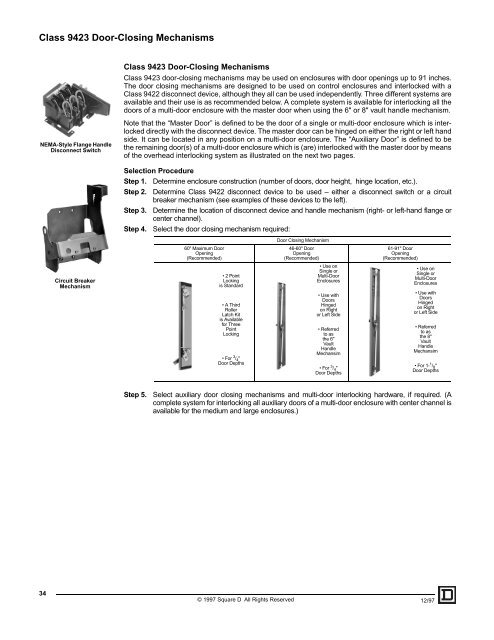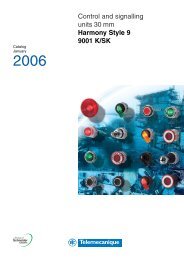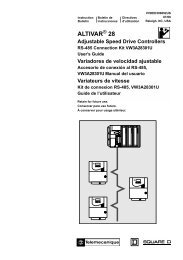Operating Mechanisms, Disconnect Switches, and Door ... - Square D
Operating Mechanisms, Disconnect Switches, and Door ... - Square D
Operating Mechanisms, Disconnect Switches, and Door ... - Square D
You also want an ePaper? Increase the reach of your titles
YUMPU automatically turns print PDFs into web optimized ePapers that Google loves.
Class 9423 <strong>Door</strong>-Closing <strong>Mechanisms</strong><br />
NEMA-Style Flange H<strong>and</strong>le<br />
<strong>Disconnect</strong> Switch<br />
34<br />
Circuit Breaker<br />
Mechanism<br />
Class 9423 <strong>Door</strong>-Closing <strong>Mechanisms</strong><br />
Class 9423 door-closing mechanisms may be used on enclosures with door openings up to 91 inches.<br />
The door closing mechanisms are designed to be used on control enclosures <strong>and</strong> interlocked with a<br />
Class 9422 disconnect device, although they all can be used independently. Three different systems are<br />
available <strong>and</strong> their use is as recommended below. A complete system is available for interlocking all the<br />
doors of a multi-door enclosure with the master door when using the 6" or 8" vault h<strong>and</strong>le mechanism.<br />
Note that the “Master <strong>Door</strong>” is defined to be the door of a single or multi-door enclosure which is interlocked<br />
directly with the disconnect device. The master door can be hinged on either the right or left h<strong>and</strong><br />
side. It can be located in any position on a multi-door enclosure. The “Auxiliary <strong>Door</strong>” is defined to be<br />
the remaining door(s) of a multi-door enclosure which is (are) interlocked with the master door by means<br />
of the overhead interlocking system as illustrated on the next two pages.<br />
Selection Procedure<br />
Step 1. Determine enclosure construction (number of doors, door height, hinge location, etc.).<br />
Step 2. Determine Class 9422 disconnect device to be used – either a disconnect switch or a circuit<br />
breaker mechanism (see examples of these devices to the left).<br />
Step 3. Determine the location of disconnect device <strong>and</strong> h<strong>and</strong>le mechanism (right- or left-h<strong>and</strong> flange or<br />
center channel).<br />
Step 4. Select the door closing mechanism required:<br />
60" Maximum <strong>Door</strong><br />
Opening<br />
(Recommended)<br />
2 Point<br />
Locking<br />
is St<strong>and</strong>ard<br />
A Third<br />
Roller<br />
Latch Kit<br />
is Available<br />
for Three<br />
Point<br />
Locking<br />
For 3 / 4 "<br />
<strong>Door</strong> Depths<br />
Step 5. Select auxiliary door closing mechanisms <strong>and</strong> multi-door interlocking hardware, if required. (A<br />
complete system for interlocking all auxiliary doors of a multi-door enclosure with center channel is<br />
available for the medium <strong>and</strong> large enclosures.)<br />
© 1997 <strong>Square</strong> D All Rights Reserved<br />
<strong>Door</strong> Closing Mechanism<br />
46-60" <strong>Door</strong><br />
Opening<br />
(Recommended)<br />
Use on<br />
Single or<br />
Multi-<strong>Door</strong><br />
Enclosures<br />
Use with<br />
<strong>Door</strong>s<br />
Hinged<br />
on Right<br />
or Left Side<br />
Referred<br />
to as<br />
the 6"<br />
Vault<br />
H<strong>and</strong>le<br />
Mechansim<br />
For 3 / 4 "<br />
<strong>Door</strong> Depths<br />
61-91" <strong>Door</strong><br />
Opening<br />
(Recommended)<br />
Use on<br />
Single or<br />
Multi-<strong>Door</strong><br />
Enclosures<br />
Use with<br />
<strong>Door</strong>s<br />
Hinged<br />
on Right<br />
or Left Side<br />
Referred<br />
to as<br />
the 8"<br />
Vault<br />
H<strong>and</strong>le<br />
Mechansim<br />
For 1- 1 / 8 "<br />
<strong>Door</strong> Depths<br />
12/97







